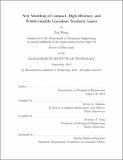| dc.contributor.advisor | Steven G. Johnson and Nicholas X. Fang. | en_US |
| dc.contributor.author | Wang, Fan,Ph. D.Massachusetts Institute of Technology. | en_US |
| dc.contributor.other | Massachusetts Institute of Technology. Department of Mechanical Engineering. | en_US |
| dc.date.accessioned | 2020-02-10T21:37:57Z | |
| dc.date.available | 2020-02-10T21:37:57Z | |
| dc.date.copyright | 2019 | en_US |
| dc.date.issued | 2019 | en_US |
| dc.identifier.uri | https://hdl.handle.net/1721.1/123716 | |
| dc.description | This electronic version was submitted by the student author. The certified thesis is available in the Institute Archives and Special Collections. | en_US |
| dc.description | Thesis: Ph. D., Massachusetts Institute of Technology, Department of Mechanical Engineering, 2019 | en_US |
| dc.description | Cataloged from student-submitted PDF version of thesis. | en_US |
| dc.description | Includes bibliographical references (pages 129-134). | en_US |
| dc.description.abstract | The terahertz region, in the heart of the electromagnetic spectrum, has been the least utilized, in part due to inadequacies of available sources. Optically pumped far-infrared (OPFIR) lasers were one of the most powerful continuous-wave terahertz sources. However, such lasers have long been thought to have intrinsically low efficiency, not tunable in frequency, and large sizes. In this thesis, we introduce a compact, frequency-tunable source of terahertz radiation with high efficiency. We first present both an innovative theoretical model and experimental validation of a Methyl Fluoride OPFIR laser at 0.25 THz that exhibits 10x greater efficiency and 1,000x smaller volume than the best commercial lasers. Unlike previous OPFIR-laser models involving only a few energy levels that failed even qualitatively to match experiments at high pressures, our ab-initio theory matches experiments quantitatively, within experimental uncertainties with no free parameters, by accurately capturing the interplay of millions of degrees of freedom in the laser. Moreover, we demonstrate a widely frequency-tunable compact terahertz radiation with laughing gas (nitrous oxide N₂O) pumped by a quantum cascade laser (QCL). In experiments, broad tunability is achieved over 31 lines spanning 0.25-0.80 THz, each with kilohertz linewidths. Our comprehensive theoretical model is able to constrain the key molecular parameters and predict the optimal performance of the laser. The concept of QCL-pumped molecular laser (QPML) is a universal while revolutionary concept characterized by unprecedented frequency tunability over a wide range of rotational transitions using a single molecular gas as the gain medium. An analytical theory for QPML is presented to study the key factors for improving the laser performance. We believe that these developments will revive interest in optically pumped molecular laser as a powerful, tunable, and compact source of terahertz radiation. | en_US |
| dc.description.statementofresponsibility | by Fan Wang. | en_US |
| dc.format.extent | 134 pages | en_US |
| dc.language.iso | eng | en_US |
| dc.publisher | Massachusetts Institute of Technology | en_US |
| dc.rights | MIT theses are protected by copyright. They may be viewed, downloaded, or printed from this source but further reproduction or distribution in any format is prohibited without written permission. | en_US |
| dc.rights.uri | http://dspace.mit.edu/handle/1721.1/7582 | en_US |
| dc.subject | Mechanical Engineering. | en_US |
| dc.title | New modeling of compact, high-efficiency, and widely-tunable gas-phase terahertz lasers | en_US |
| dc.type | Thesis | en_US |
| dc.description.degree | Ph. D. | en_US |
| dc.contributor.department | Massachusetts Institute of Technology. Department of Mechanical Engineering | en_US |
| dc.identifier.oclc | 1139520990 | en_US |
| dc.description.collection | Ph.D. Massachusetts Institute of Technology, Department of Mechanical Engineering | en_US |
| dspace.imported | 2020-02-10T21:37:53Z | en_US |
| mit.thesis.degree | Doctoral | en_US |
| mit.thesis.department | MechE | en_US |
